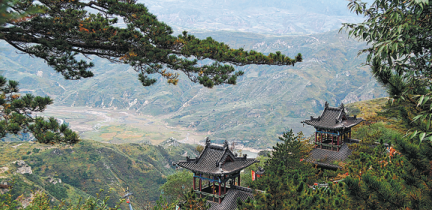Sacred mountain host to 'engineering miracle'
Updated: 2021-06-25

Mount Hengshan in Hunyuan county, Shanxi province, is one of the five sacred mountains in China. [Photo by Li Yi for China Daily]
As one of five sacred mountains in China, Mount Hengshan is about 10 kilometers south of Hunyuan county and 62 km from downtown Datong, Shanxi province.
Like other mountains in China with a strong Taoist presence, Hengshan has been considered sacred since the Western Zhou Dynasty (c. 11th century-771 BC).Standing 2,016.8 meters above sea level, Tianfengling is the main peak of Hengshan, which is surrounded by a number of peaks almost its height.
Like other sacred mountains in China, Hengshan is known for its temples and monasteries, which are mainly located on the southern slope of Tianfengling.
The leading temple in Hengshan is called Beiyue Temple, or the Shrine of the Northern Mountain. First built during the Han Dynasty (206 BC-AD 220), the main structures which remain were built during the Ming Dynasty (1368-1644). It is accessed via a 103-step stairway.
The temple was dedicated to the mountain god. Mount Hengshan's god has had a steady rise in status over thousands of years. It evolved from a minor deity two millennia ago to a major one with a status next to the Jade Emperor in Chinese mythology during the Song Dynasty (960-1279).
However, despite Beiyue Temple hosting the main god of the region, the most renowned ancient structure in Hengshan is Xuankong Temple.
Xuankong Temple, also known as Hanging Temple, was first built in the Northern Wei Dynasty (386-534), about 1,500 years ago.
Constructed of wood, tiles and stones, the temple is made of two three-story pavilions and a yard linked by staircases and steps. The staircases and steps line the face of a sheer cliff 50 meters above a stream at the foot of Hengshan.
From the ground, Xuankong Temple appears extremely precarious. It is supported only by a few thin stanchions standing on protruding rocks. For that reason, it was selected by Time magazine as one of the 10 most precarious buildings in the world in 2010.
Sun Shupeng, chief engineer at Shanxi Ancient Architecture Group, however, refuted the notion that Xuankong Temple is a dangerous structure.
"The temple has been standing firmly on the Hengshan cliff for more than 1,500 years and is still kept intact and solid," Sun said. "A study of the temple is an exploration of an ancient Chinese engineering miracle."
Peng Ke'er contributed to this story.



